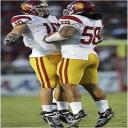Yahoo Answers is shutting down on 4 May 2021 (Eastern Time) and the Yahoo Answers website is now in read-only mode. There will be no changes to other Yahoo properties or services, or your Yahoo account. You can find more information about the Yahoo Answers shutdown and how to download your data on this help page.
Why do some types of aircraft have their wingtips turned up?
I just wondered what the advantage is, and why all aircraft don't have that feature. Thank you in advance.
All these answers are first-class: informative; concise; very helpful; very interesting. I wish that I could choose every one of them as best answer! Many thanks to you all!
7 Answers
- WalterLv 41 decade agoFavourite answer
Good article from the poster above.
Basically, winglets reduce the drag on an aircraft produced by vortices (which are known to cause wake turbulence, especially during approach and take off). This in turn means the aircraft is more fuel efficient and so, can travel a greater range. This also means airlines save money on fuel costs too, which is always a plus.
Winglets have been used by military aircraft prior to commercial airliners. It's still a new concept for the airliners though, which is why there are still quite a few aircraft without them. I know Boeing aim to add them on to most of their aircraft, including the Boeing 787 and Boeing 747-800.
Source(s): Airline pilot - Anonymous1 decade ago
There are some pretty good answers here, but as far as the airlines are concerned it saves fuel. as for the aerodynamic factor, it delays the separation of what is called the boundary layer. which is basically to say that the flow of air is diverted up that little ramp type wing, and thus it creates less drag on other parts of the aircraft. some of these work better than others. for example airbus has pretty much just attached their winglet as an addition and looks like a silly little aerodynamic plate. boeing's was actually designed for the aircraft and proves more efficient because of its less fence like structure. also the boundary layer is a thin layer of air that runs off of the wing. overall is saves money, looks really cool and depending on the design is pretty efficient.
as to your question about the reasoning between having them on all aircraft; cost. most planes have to be retrofitted if they don't already have them, and others come from the factory with winglets.
Source(s): I am a pilot that studies aerodynamics. - TechwingLv 71 decade ago
Those turned-up wingtips are called winglets. They reduce drag, which improves fuel efficiency. The gain is typically around five percent in fuel economy.
Some airlines chose not to use them, some aircraft types cannot accept them, and some aircraft don't benefit much from them, so you don't always see them used. They are increasingly popular, however. For many aircraft, they can either be equipped with winglets at the factor, or they can be added later on.
- Anonymous1 decade ago
Those are called winglets and they prevent wind tumbling off the ends of the wing creating drag and reducing lift.
The design came from eagles, the birds, you will never see a picture of an eagle soaring without the wingtips turned up.
- 1 decade ago
The winglets increase the span efficiency factor which results in a decrease in induced drag by reducing the effect of the vortices.
C_Di=CL^2/(pi*e*AR) where e is the efficiency factor.
- 1 decade ago
they are made to eliminate drag which is produced due to vortex.as u know wing has higher pressure on the lower side and low pressure on the upper side that y is flying ....so when this higher pressure region reaches the tip(wing tip) they tend to curl clockwise and anti clock wise on both port and star board wing... this action tend to push the wing down so when u keep the tip upward or downward they will prevent this.even some aircraft even have tip tanks to prevent this and to provide some life.and high speed aircraft do have this features.




